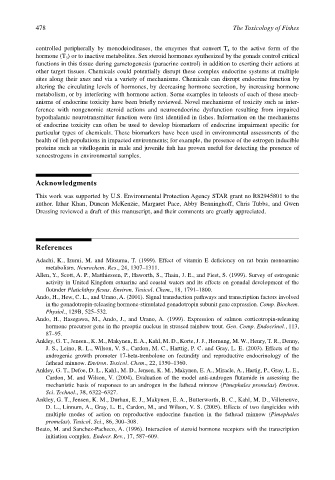Page 498 - The Toxicology of Fishes
P. 498
478 The Toxicology of Fishes
controlled peripherally by monodeiodinases, the enzymes that convert T to the active form of the
4
hormone (T ) or to inactive metabolites. Sex steroid hormones synthesized by the gonads control critical
3
functions in this tissue during gametogenesis (paracrine control) in addition to exerting their actions at
other target tissues. Chemicals could potentially disrupt these complex endocrine systems at multiple
sites along their axes and via a variety of mechanisms. Chemicals can disrupt endocrine function by
altering the circulating levels of hormones, by decreasing hormone secretion, by increasing hormone
metabolism, or by interfering with hormone action. Some examples in teleosts of each of these mech-
anisms of endocrine toxicity have been briefly reviewed. Novel mechanisms of toxicity such as inter-
ference with nongenomic steroid actions and neuroendocrine dysfunction resulting from impaired
hypothalamic neurotransmitter function were first identified in fishes. Information on the mechanisms
of endocrine toxicity can often be used to develop biomarkers of endocrine impairment specific for
particular types of chemicals. These biomarkers have been used in environmental assessments of the
health of fish populations in impacted environments; for example, the presence of the estrogen inducible
proteins such as vitellogenin in male and juvenile fish has proven useful for detecting the presence of
xenoestrogens in environmental samples.
Acknowledgments
This work was supported by U.S. Environmental Protection Agency STAR grant no R82945801 to the
author. Izhar Khan, Duncan McKenzie, Margaret Pace, Abby Benninghoff, Chris Tubbs, and Gwen
Dressing reviewed a draft of this manuscript, and their comments are greatly appreciated.
References
Adachi, K., Izumi, M. and Mitsuma, T. (1999). Effect of vitamin E deficiency on rat brain monoamine
metabolism. Neurochem. Res., 24, 1307–1311.
Allen, Y., Scott, A. P., Matthiessen, P., Haworth, S., Thain, J. E., and Fiest, S. (1999). Survey of estrogenic
activity in United Kingdom estuarine and coastal waters and its effects on gonadal development of the
flounder Platichthys flesus. Environ. Toxicol. Chem., 18, 1791–1800.
Ando, H., Hew, C. L., and Urano, A. (2001). Signal transduction pathways and transcription factors involved
in the gonadotropin-releasing hormone-stimulated gonadotropin subunit gene expression. Comp. Biochem.
Physiol., 129B, 525–532.
Ando, H., Hasegawa, M., Ando, J., and Urano, A. (1999). Expression of salmon corticotropin-releasing
hormone precursor gene in the preoptic nucleus in stressed rainbow trout. Gen. Comp. Endocrinol., 113,
87–95.
Ankley, G. T., Jensen., K. M., Makynen, E. A., Kahl, M. D., Korte, J. J., Hornung, M. W., Henry, T. R., Denny,
J. S., Leino, R. L., Wilson, V. S., Cardon, M. C., Harttig, P. C. and Gray, L. E. (2003). Effects of the
androgenic growth promoter 17-beta-trenbolone on fecundity and reproductive endocrinology of the
fathead minnow. Environ. Toxicol. Chem., 22, 1350–1360.
Ankley, G. T., Defoe, D. L., Kahl., M. D., Jensen, K. M., Makynen, E. A., Miracle, A., Hartig, P., Gray, L. E.,
Cardon, M. and Wilson, V. (2004). Evaluation of the model anti-androgen flutamide in assessing the
mechanistic basis of responses to an androgen in the fathead minnow (Pimephales promelas) Environ.
Sci. Technol., 38, 6322–6327.
Ankley, G. T., Jensen, K. M., Durhan, E. J., Makynen, E. A., Butterworth, B. C., Kahl, M. D., Villeneuve,
D. L., Linnum, A., Gray, L. E., Cardon, M., and Wilson, V. S. (2005). Effects of two fungicides with
multiple modes of action on reproductive endocrine function in the fathead minnow (Pimephales
promelas). Toxicol. Sci., 86, 300–308.
Beato, M. and Sanchez-Pacheco, A. (1996). Interaction of steroid hormone receptors with the transcription
initiation complex. Endocr. Rev., 17, 587–609.

